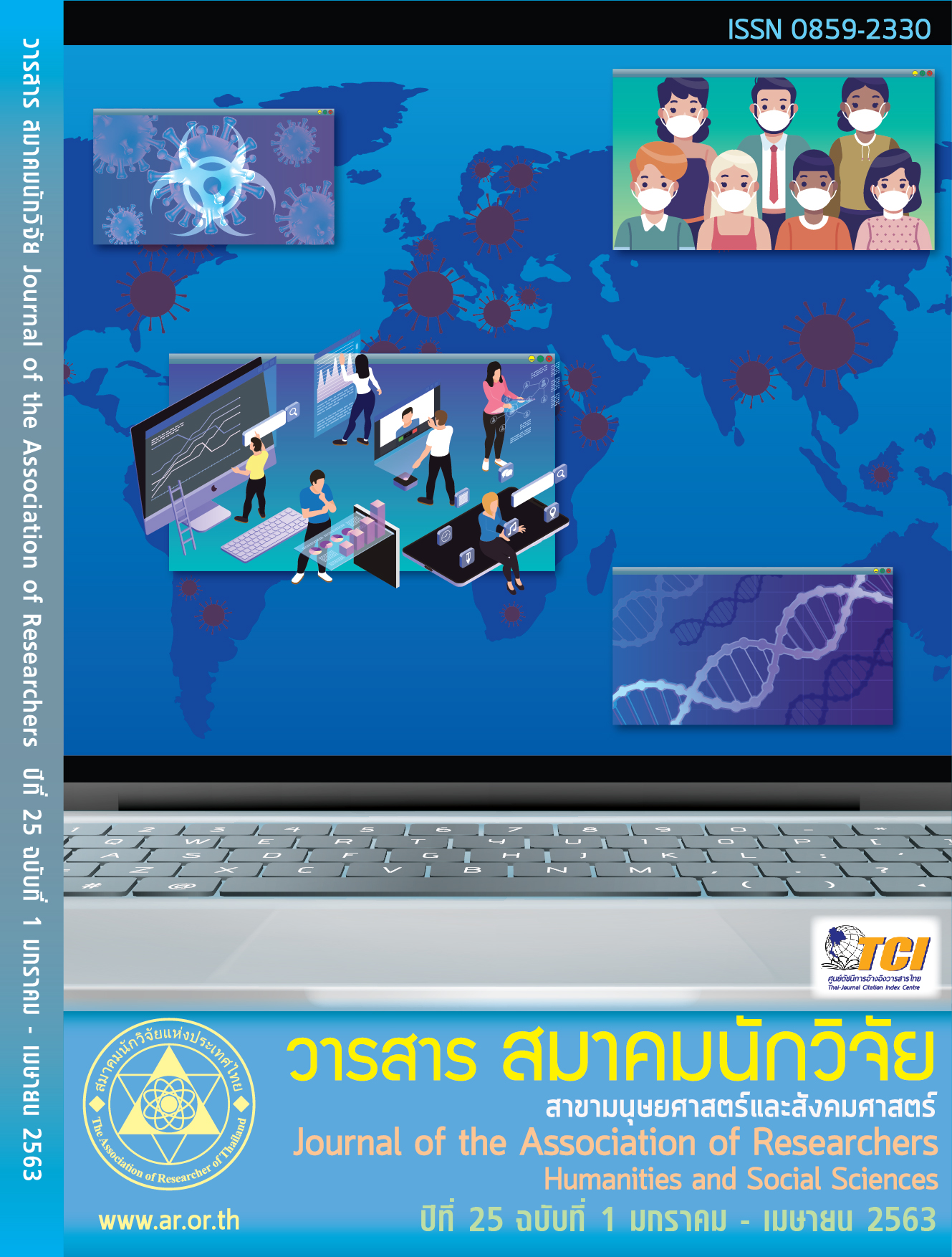Enhancing A Competitive Advantage Through Supply Chain Management AndInformation Technology Management
Main Article Content
Abstract
The main objective of this study is to examine the impacts of supply chain management and information technology management on competitive advantage by using Structural Equation Modeling (SEM). The sample was chosen from companies in the automotive parts manufacturing industry in Thailand, the questionnaires were distributed to 540 respondents. The statistical treatment of this study is based upon the statistical
techniques such as frequency and percentage, means and standard deviation, and SEM. The results showed that the conceptual model aligns with the empirical data /df = 1.435, GFI = 0.921, AGFI = 0.942, CFI = 0.952 and RMSEA = 0.045. The findings of this research indicated that supply chain management has impact on competitive advantage at significance level 0.01. Furthermore, the result demonstrated that information technology management has effect on supply chain management at significance level 0.01. Additionally, the outcome showed that information technology management has direct and indirect impact on competitive advantage at significance level 0.01
Article Details
บทความที่ปรากฏในวารสารนี้ เป็นความรับผิดชอบของผู้เขียน ซึ่งสมาคมนักวิจัยไม่จำเป็นต้องเห็นด้วยเสมอไป การนำเสนอผลงานวิจัยและบทความในวารสารนี้ไปเผยแพร่สามารถกระทำได้ โดยระบุแหล่งอ้างอิงจาก "วารสารสมาคมนักวิจัย"
References
จากhttps://www.kasikornbank.com/th/business/sme/KSMEKnowledge/article/KSMEAnalysis/Documents/ThaiAutomotive4.pdf
สุภมาส อังศุโชติ, สมถวิล วิจิตรวรรณา และ รัชนีกูล ภิญโญภานุวัฒน์. (2551)
สถิติวิเคราะห์สำหรับการวิจัยทางสังคมศาสตร์และพฤติกรรมศาสตร์: เทคนิคการใช้โปรแกรม LISREL. กรุงเทพฯ: มิสชั่น มีเดีย.
สวัสดิ์ วรรณรัตน์ (2561) โมเดลสมการโครงสร้างของการจัดการคุณภาพทั่วทั้งองค์กร
นวัตกรรมและผลการดำเนินการโซ่อุปทาน, เศรษฐศาสตร์และบริหารธุรกิจปริทัศน์, 14(1), 105-127.
References
Alemu, A. E., Maertens, M., Deckers, J., Bauer, H., & Mathijs, E. (2016).
Impact of supply chain coordination on honey farmers' income in tigray,
northern ethiopia. Agricultural and Food Economics, 4(1), 1-21.
Arthur, S. M. (2017). Sustainable supply chain: Maintaining a competitive advantage in
retail organizations. Doctoral dissertation, Walden University, Minnesota, United States of America.
Bentler, P. M. (1995). EQS structural equations program manual (Vol. 6). Encino, CA: Multivariate software.
Biraori, O. E., Nyamasege, O. J., & Joseph, B. N. (2015) Information Technology And
The Effectiveness Of Supply Chain Management In The Kenya Public Sector. International Journal
Of Information, Business And Management, 7(3), 237-250.
Blanchard, D. (2014) Supply chain & logistics: The competitive advantage of a supply chain.
Industry Week, Retrieved June 17, 2018. from https://www.industryweek.com/competitive-chain
Carbone, A. (2017). Erratum to: Food supply chains: Coordination governance
and other shaping forces. Agricultural and Food Economics, 5(1), 1
Datta, P. P. (2017). Enhancing competitive advantage by constructing supply
chains to achieve superior performance. Production Planning & Control, 28(1), 57-74
Du, W., Fan, Y., & Yan, L. (2018). Pricing strategies for competitive water supply chains under different power structures:
An application to the south-to-north water diversion project in china. Sustainability, 10(8), 2892.
Ferry, J., Parton, K. A., & Cox, R. J. (2013). Linking supply chain practices to
competitive advantage. British Food Journal, 115(7), 1003-1024.
Fornell, C. & Larcker, D.F. (1981). Evaluating structural equation models with unobservable
variables and measure. Journal of Marketing Research, 18, 39-50.
Gholami, S., & Shahroodi, K. (2016). Studying The Relationship Between The Empowerment Of Information
Technology, Supply Chain Flexibility And Competitive Advantage. Arabian Journal
Of Business And Management Review (Oman Chapter), 5(12), 43-50.
Goswami, S., Engel, T., & Krcmar, H. (2013). A comparative analysis of information
visibility in two supply chain management information systems. Journal of
Enterprise Information Management, 26(3), 276-294.
Hair, J., Black, W., Babin, B., & Anderson, R. (2014). Multivariable data analysis 7th ed. New Jersey: Pearson.
Hatani, L., Zain, D., & Wirjodirjo, B., (2013). Competitive Advantage as Relationship
Mediation between Supply Chain Integration and Fishery Company Performance
In Southeast Sulawesi (Indonesia). IOSR Journal of Business and Management, 6(5): 1-14.
IMVM. (2018). International Organization of Motor Vehicle Manufacturers 2018.
Retrieved September 2, 2018. from http://www.oica.net/category/production-statistics/2017-statistics/
Jeong, B., & Yoon, J. (2017). Competitive intelligence analysis of
augmented reality technology using patent information. Sustainability, 9(4), 497.
Jie, F., Parton, K. A., & Cox, R. J. (2007). Supply chain practice, supply chain performance indicators
and competitive advantage of australian beef enterprises: A conceptual framework.
Australian Agricultural and Resource Economics Society (AARES 51st Annual Conference), 1-29.
Khaksar, E., Abbasnejad, T., Esmaeili, A., & Tamosaitiene, J. (2016). The effect of green supply
chain management practices on environmental performance and competitive advantage:
A case study of the cement industry. Technological and Economic Development of Economy, 22(2), 293-308.
Kwak, D., Seo, Y., & Mason, R. (2018). Investigating the relationship between supply
chain innovation, risk management capabilities and competitive advantage in global supply chains.
International Journal of Operations & Production Management, 38(1), 2-21.
Lees, N. J., & Nuthall, P. (2015). Case study analysis on supplier commitment to
added value agri-food supply chains in new zealand. Agricultural and Food Economics, 3(1), 1-16.
Loo, R., & Thorpe, K. (2000). Confirmatory factor analyses of the full and short versions of
the Marlowe-Crowne Social Desirability Scale. The Journal of social psychology, 140(5), 628-635.
Mani, V., Delgado, C., Hazen, B. T., & Patel, P. (2017). Mitigating supply chain risk via
sustainability using big data analytics: Evidence from the manufacturing supply chain. Sustainability, 9(4), 608.
Marciniak, R. (2005). Does it matter? Information technology and the corrosion
of competitive advantage/Mobilités.net villes, transports, technologies face aux
nouvelles mobilités. Systèmes d'Information Et Management, 10(2), 135-136.
Matchette, J. B. & Von, H. L. (2006). How to enable profitable
growth and high performance. Supply Chain Management Review. 10(4), 49-54.
Mendoza-Fong, J., García-Alcaraz, J. L., Emilio Jiménez Macías, Ibarra Hernández,
N. L., Díaz-Reza, J. R., & Julio, B. F. (2018). Role of information and communication technology
in green supply chain implementation and companies’ performance. Sustainability, 10(6), 1793
Paulraj, A. and I. J. Chen. (2007). Strategic Buyer-Supplier Relationships,
Information Technology and External Logistics Integration. Journal of Supply chain Management 43(2), 2-14.
Simon, J. (2015). Concepts of the internet of things from the aspect of the
autonomous mobile robots. Interdisciplinary Description of Complex Systems, 13(1), 34-40.
Translated Thai References
KASIKORN Research Center. (2018). Automotive Trend. Retrieved August 8, 2018.
from https://www.kasikornbank.com/th/business/sme/KSMEKnowledge/article/KSMEAnalysis/Documents/ThaiAutomotive4.pdf. (in Thai).
Supamas Angsuchoti, Somtawin Wijitwanna and Ratchaneekool Pinyopanuwat. (2008).
Statistical analysis for research in social science and behavior science: techniques for using
LISREL programs. Bangkok. Mission Media. (in Thai).
Sawat Wanarat. (2018). A Structural Equation Model of Total
Quality Management, Innovation and Supply Chain Performance. Business
Administration amd Economics Review, 14(1), 105-127. (in Thai).


